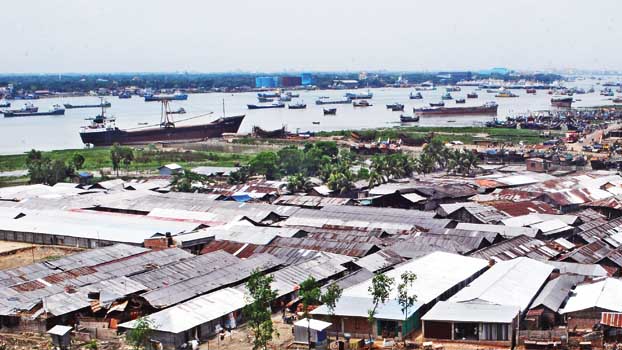Salinity grips Karnaphuli


The Karnaphuli River, in the port city of Chattogram, is faced with disaster for the rapid increase of salinity that has gone at least 50 kms upstream in the last 3 decades.
This river is known as a key source of freshwater in Chattogram and adjoining hilly districts.
Salinity and pollution have severely hampered biodiversity as well as the livelihoods of river-dependent people and industrial production on both banks.
According to data of Chattogram Urea Fertilizer Company Ltd (CUFL), the only authority that measures salinity in the Karnaphuli river, in 34 years since 1987 at Kalurghat, salinity was 2 Parts- Per Million PPM. But at the same point in recent years, there is a salinity of near to 5800 PPM, while the tolerable level of salinity in water for human consumption is 5 PPM.
Although there is no regular arrangement to measure salinity after Kalurghat, locals and researchers in the areas say the salinity has reached Rangunia, more that 20 km upstream of Kalurghat. That means a total of 50KM of the Karnaphuli river is now affected by salinity.
Abdur Rahim, Managing Director of CUFL said, “We collect around 18-20 million litres of water from the Karnaphuli per day, but the factory had to be closed for 72 days this year due to increased salinity in the water. If it is closed for one day, an average of TK 4 crore is lost. During the 72-day closure this year, the losses reached around Tk 288 crore.”
Depending on the river water, it has become difficult to maintain regular production, as the water here is used as a raw material for making fertilizer along with air and gas, he added.
There are at least 350 factories on both the banks of the river Karnaphuli which depend on the water of the river.
The salinity of the river water is generally expected to be low during the monsoon season; but it is now high during the monsoon season as well as during the dry season.
The amount of salinity varies with the tides. Of these, salinity is higher at high tide and lower at ebb tide. However, high water flow from upstream reduces salinity.
The flow of fresh water in the Karnafuli River is mainly controlled by the Kaptai Hydropower Project. An average of 7,000 to 10,000 cusecs of water is released into the Karnaphuli every day. During the dry season, when the water level in Kaptai Lake decreases, power generation stops and at this time there is no flow of fresh water in the Karnaphuli.
Where more than 150 species of fish were found once, now only 8/10 species of fish are available. Of these, 59 species of mixed water fish and 65 species of freshwater fish have become extinct, said Manjurul Kibria, professor of the Biology Department of Chattogram University.
He also said, a species of snake, Patal Nagini, is also found in the Halda River, a branch of the Karnaphuli, suggesting that the environment is changing rapidly and becoming suitable for species capable of living in saline environments.
The Halda is also known as a famous natural breeding ground for freshwater carp fishes of Asia.




